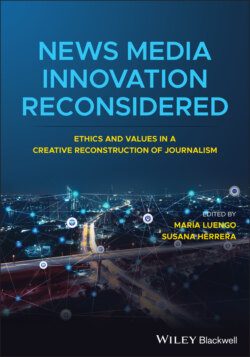Читать книгу News Media Innovation Reconsidered - Группа авторов - Страница 25
Newsrooms as Communities of Practice
ОглавлениеProfessional news practices, such as the proper transcription of a statement, the verification of the source of an amateur video, or the double-checking of the information provided by a source, always have an ethical dimension (Suárez-Villegas and Cruz-Álvarez, 2016a). In this sense, the coherence of journalistic practices differentiates the professional activity from the amateur level. There are few shared values about the professional practices in journalism. The ethical decision depends on each professional, who is solely responsible for their own actions. Companies carry out the reporting activity, but specific individuals, men, and women with their beliefs and ethical convictions, are the ones who produce the news.
Journalists are continually transforming their traditions in the newsgathering, production, and distribution processes. News practitioners follow the criteria about what they consider appropriate, true, and fair, according to newsroom standards and professional culture. Through a process of trial and error, journalists incorporate the innovations as appropriate practices or dismiss them as unacceptable. The application of ethical standards, in short, determines the very nature of the journalistic activity as a professional practice in the full sense of the term.
Professions can become “communities of practice” whose members share a common identity and goals. According to Alasdair Macintyre (1984), the effectiveness of a community of practice depends on the degree of cohesion among its members. In any professional community, Macintyre (1984, pp. 65–67) identifies three main characteristics:
1 The need for learning how to carry out that activity in a professional way.
2 Excellence provides the participants with the goal of their activity.
3 The learning process, based on decision-making and the assessment of actions, products, and people, allows practitioners to evaluate their own performance and to reach excellence.
In fact, the profession of journalism is an example of practice in the sense referred to by Macintyre (1984), since newsrooms can be regarded as communities of professionals, made up of journalists who share their own standards and procedures for producing information, according to the criteria that emanate from newsroom managers and employees (García-Avilés, 2014).
News standards are passed on from one generation of journalists to another, through professional practices. Journalistic ethical standards cover practical issues, such as how to edit an online news video or how to produce a VR report. Each of these activities can adapt to the ethical criteria of that community of practitioners. In these communities of practice, “a philosophy of moral values guiding journalists is shaped by the journalist or journalism organization’s need to be perceived by its audience as contributing to the public discourse by supplying factual, reliable, and meaningful information” (Hayes, Singer, and Ceppos, 2007, p. 265).
Learning and knowledge sharing foster innovation in these professional communities. In this sense, the communities of practice share ethical norms about the acquisition, production, and distribution of contents, in order to illuminate “the ethical conscience of the professional who applies the norms to the specific circumstances of each case” (Jiménez, 2016, p. 26).
Journalistic ethics also translates into the “good practices” which take place during the decision-making process in the newsrooms (García-Avilés, 2014). The issues discussed allow for shared and transparent results, so that the public can learn about the decisions taken in producing the news and their justification. For this reason, journalists should be held accountable for the procedures they use in newsgathering, production, and distribution, to provide a responsible journalism that serves the public (Eberwein, Fengler, and Karmasin, 2019). This approach contributes to updating the standards of professional excellence and ethical values in the innovative practices, which often are not included in traditional codes.
Throughout this process, journalists can engage with users who share a similar concern for news quality. As former La Vanguardia’s ombudsman Roger Jiménez (2016, p. 31) emphasizes, some readers “use the news content with a critical mentality, raise the finger when they perceive biases, systematic distortions or silences, prosecute the selection and placement of photos, and censure the prejudices that can slip into the stories.” Thus, media managers must take advantage of the readers’ contributions because they are an ethical asset for their news operations.
Ethical debates should incorporate all the issues that arise from innovations in news product and service, process of production and distribution, use of technology, social media, misinformation, etc. In Ward’s words (2014, p. 468), “traditional media ethics is strong on abstract principles that cover all forms of journalism—such as acting independently and seeking the truth. But it is weak on specifying guidelines and protocols for different forms of media.” In conclusion, newsroom ethics should respond to the current challenges faced by digital journalism and the mechanisms by which news is produced.
